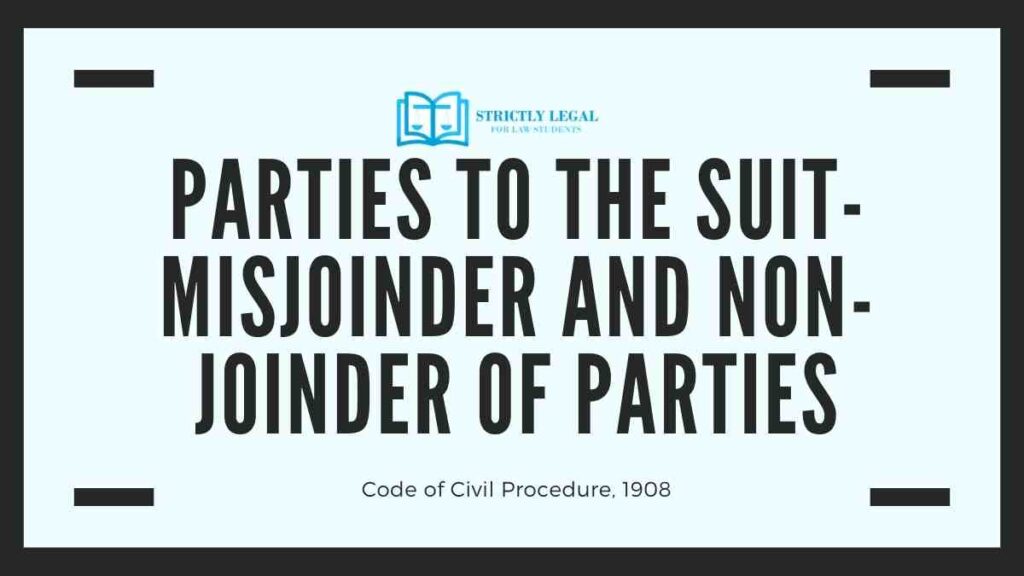Civil Law speaks for a private right of an individual of action of rectification. A civil proceeding, also known as a civil suit, is a process for recuperation of an individual’s right or redress (rectification) of an individual’s wrong. The necessary credentials that were mandated of any civil suit, as per the decision of the Honorable Bombay High Court in Krishnappa v. Shivappa, are that the opposing parties, the subject matter in dispute, the cause of action, and the relief claimed by the plaintiff.
Nonetheless, the opposing parties are referred to as the petitioner and the respondent, respectively. The Code of Civil Procedure, 1908 (CPC) [herein referred to as the code] is a procedural law that is classified into two parts- “Body of the Code” and “Rules”. The second one throws light on non-joinder of parties. Order 1 of the Code of Civil Procedure specifies the parties to suit and also carries provisions for addition, deletion, and substitution of parties, joinder, non-joinder, and misjoinder of parties, and objections to non-joinder, and misjoinder.
Table of Contents
UNDERSTANDING “JOINDER” AND “MISJOINDER”
There is persistent anxiety while filing a civil suit as if all the parties to the suit are taken into consideration for an account or not. Additionally, if any party(s) are missing, they can be taken into consideration also and can be added or joined later in a suit as another issue, provided, the CPC has any provision to remedy to add party(s) to the suit by the procedure of “joinder” and the remaining pertains to the discretion of the Honorable Court under Order1- rule 2 and rule 3 read with Order 2 rule 3 and rule 4 of the CPC.
Joinder of Plaintiffs:
Anybody or anyone may join in one suit as plaintiffs as per the required conditions under Rule 1 of Order 1. These conditions that are necessary to be consummated are the right to relief claiming to exist in each of the plaintiffs that come out of the same act of transaction; and the case is such of a character that, if such person got separate suits, any common question of law or question of fact may arise.
Joinder of Defendants:
Just the opposite to the joinder of plaintiffs, that, a persona can join as a defendant as per the provisions of Rule 3 of Order 1. The conditions that are necessary to be satisfied in the case of a defendant is the right to relief claiming to exist against them comes out of the same act of transaction; and the case is of such a nature that, if separate suits are brought against such a person, any common question of law or question of fact may arise.
THE NECESSARY PARTIES TO A CIVIL SUIT
A necessary party is that party without whom a claim or allegation cannot be settled by the Honorable Court legally. In layman’s terms, in the absence of a “necessary party”, no efficacious and absolute decree can be passed by the Court.
In Benaras Bank v. Bhagawan Das Ltd. [A.I.R. 1947 All. 18], the Honorable Bench of the High Court of Allahabad specified two tests that would determine the questions about whether a specific party is a necessary party to a proceeding. The tests are as follows:
- A right of relief has to be present against such a party with regard to the matters involved in the suit.
- In the absence of such a party, the court must not be in a position to pass an efficacious decree.
Nonetheless, the aforementioned tests, as provided by the Honorable Bench of Allahabad High Court were explained as true tests by the Honorable Supreme Court of India in Deputy Commissioner, Hardoi v. Rama Krishna.
MISJOINDER OF PARTIES
The joinder or incorporation of any person as a party to a suit, opposite to the provisions of the Code is known to be a misjoinder. Grounds for a court ruling that there is a misjoinder incorporate that:
- The parties to the suit do not have the same rights to a judgment.
- They have a conflict of interests.
- The situations in each allegation must be unique or contradictory.
- Even to a bit, the defendants are not involved in the same transaction. In the case of a criminal prosecution, the most usual cause for misjoinder is the defendants are found to be involved in various claimed crimes or the charges are based on separate unique transactions.
However, a misjoinder may be a misjoinder of plaintiffs or a misjoinder of the cause of action.
MISJOINDER OF PARTIES
The joinder or incorporation of any person as a party to a suit, opposite to the provisions of the Code is known to be a misjoinder. Grounds for a court ruling that there is a misjoinder incorporate that:
- The parties to the suit do not have the same rights to a judgment.
- They have a conflict of interests.
- The situations in each allegation must be unique or contradictory.
- Even for a bit, the defendants are not involved in the same transaction. In the case of a criminal prosecution, the most usual cause for misjoinder is the defendants are found to be involved in various claimed crimes or the charges are based on separate unique transactions.
However, a misjoinder may be a misjoinder of plaintiffs or a misjoinder of a cause of action.
Misjoinder of Plaintiffs
Where two or more persons may have joined as Plaintiffs in one suit but the Right to Relied claimed to exist in each plaintiff, does NOT come out of the same act or same transaction (or series) and if separate suits were brought by each of the plaintiff, no common question of fact or question of law may have arisen, there shall be a misjoinder of plaintiff.
Misjoinder of Defendants
In a similar way, where two or more persons may have joined as Defendants in one suit but the Right to Relied claimed to exist in each defendant, does NOT come out of the same act or same transaction (or series) and if separate suits were brought by each of the defendant, no common question of fact or question of law may have arisen, there shall be a misjoinder of defendant.
Misjoinder of Cause of Action
This aspect may be coexisting with misjoinder of plaintiffs or misjoinder of defendants. Hence, the subject may be considered pertaining to the following heads.
Misjoinder of Plaintiffs and Cause of Action
Where there are two or more plaintiffs in a suit and two or more causes of action, the plaintiffs shall be interested jointly in all the causes of action. If not, the case is one of misjoinder of plaintiffs and cause of action.
Misjoinder of Defendants and Cause of Action: Multifariousness
Where there are two or more defendants in a suit and two or more causes of action, the suit will be bad for misjoinder of defendants and causes of action, nonetheless, if unique causes of action are joined against different defendants separately, such a misjoinder is technically called multifariousness or assortment.
DIFFERENCE BETWEEN MISJOINDER AND NON JOINDER OF PARTIES
| MISJOINDER | NON JOINDER |
| When a party was added to the suit by mistake, it is misjoinder. | When a party is necessary to the suit and he was not added to the suit, he is non-joinder. |
| No probability of dismissal as it won’t be of any use to the interest of the parties. | There are probabilities of dismissing the suit with regards to the decree of the order. |

Law student.
Turning legal insights into engaging narratives.




